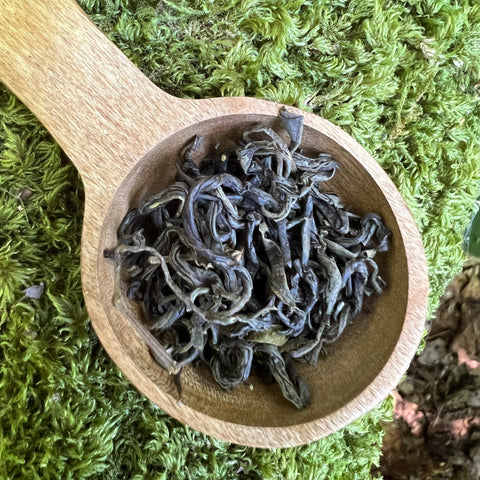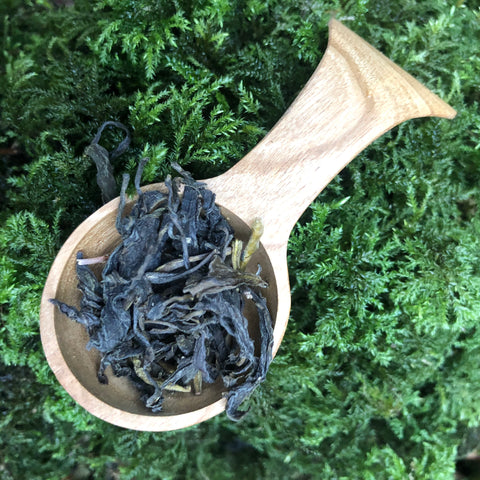Tokuya’s Kabusecha Tea [Gokou cultivar]
£9.50
Simply put...
A soft, light & sweet Kabusecha tastes of nature & Tokuya's wild tea gardens. Gokou is one of the best cultivars for shaded teas. When it’s shaded it brings out pronouced sweet notes.
Please note that Tokuya grows his tea using natural cultivation. This is reflected in the taste. In Tokuya's words : ' When you experience it, it is not a taste that you can easily feel on the tip of your tongue, but it has a natural texture that soaks into your body, and you will feel the taste deep inside your body. These are common characteristics of my tea leaves'
A note about Kabusecha
There are three types of green tea: Sencha, Kabusecha and Gyokuro. Let's hear from Tokuya - after all he grows this beautiful tea!
.
'Kabusecha and Gyoruro are similar in that they block out the sun's rays. The tea leaves that sprout in spring are made into sweet tea leaves by shading the sunlight. When the tea leaves are exposed to sunlight, the tea leaves grow and open one by one. In other words, the umami stored in the roots of tea transforms into astringency as it grows. When the light of the sun is blocked, the transformaton is suppressed. Therefore, tea leaves that are shaded from the sun have a lot of theanine and have a sweet taste.
.
Kabusecha and Gyokuro differ in the method and duration of shading from the sun.
"Kabuse" in Kabusecha means "covered". As the name suggests, it covers the tea tree directly with a shading net from the sunlight. Duration is 2 weeks or more.
.
For Gyokuro, pillars are set up in the tea plantaion, and the ceiling and walls are made of a sun- shading net, which blocks the sunlight like a room.
Duration is 3 weeks or more. This method is the same way to grow tea leaves that become matcha.
.
Sencha is green tea made from tea leaves grown in the sun. As you know, the more sunlight it grows in, the more astringent it becomes. That is why I pick when it is still young'
.
In more depth....
Cultivar : Gokou [see above]
.
Origin : Cedar Valley Gokou tea garden
.
Location : Kizugawa, Kyoto
.
Date of picking & manufacture : 16/5/23
.
Covered : Since 30/4 - 15 days
Machine or hand picked : Machine
How to prepare [Kyusu]
Amount of tea (200 ml): 3 g (1 tsp)
Water temperature: 80℃
Infusion / brewing time: 1-2 minutes
Number of infusions: 3-4
How to enjoy: No sugar, no milk.
Tales for the Tea Trade
June 2023 and we headed towards a shrine in the heart of rural Kyoto to meet with Tokuya. It was a trip driven by an interest in natural tea cultivation & a fascination to learn more about Tokuya's story :-
.
'I used to use pesticides too. However my health was destroyed by chronic pesticide poisoning. This prompted us to switch to tea cultivation that does not use pesticides or fertilizers. I learned about Aikido, a traditional Japanese martial art, training, diet, and repairing my health without drugs. That experience is the foundation of my natural cultivation. It's been 10 years since I switched to natural cultivation. It looks like the tea tree is changing vigorously year by year'
.
Tea growing is for Tokuya a way of life; a philosophy, and this is reflected in the unique profile of the teas made here. As Tokuya explains : 'What can be said in common to all is the influence of the way the tea tree grows.The more fertilizer applied, the more Teanine, but also the more catechins. Therefore, it becomes a tea with strong Umami, bitterness and astringency. In addition, the tea leaves become rotten easily due to excessive nutrition, and rotten odors and harshness are likely to occur. As you saw when you visited, I do not give them pesticides or fertilizers. Without nutrition, the tea tree grows its roots and takes in nutrients by itself. This leads to drawing out the vitality fo the tea tree. These methods are not agricultural, but the essence of Aikido, a traditional Japanese martial art that I learned. In this way, tea leaves that are not given fertilizer and grow by absorbing nutrients be themselves do not have a strong umami taste, but they have a very complex taste rather than a monotonous taste, and are affected by soil and climate. When you experience it, it is not a taste that you can easily feel on the tip of your tongue, but it has a natural texture that soaks into your body, and you will feel the taste deep inside your body. These are common characteristics of my tea leaves, even though they are made in different ways and have completely different flavors, aromas and colors'


![Tokuya’s Kabusecha Tea [Gokou cultivar]](http://cominstea.com/cdn/shop/files/FA33151A-2426-422C-915F-A7EA655545EA_1024x1024.jpg?v=1692688148)
![Tokuya’s Kabusecha Tea [Gokou cultivar]](http://cominstea.com/cdn/shop/files/FA33151A-2426-422C-915F-A7EA655545EA_grande.jpg?v=1692688148)
![Tokuya’s Kabusecha Tea [Gokou cultivar]](http://cominstea.com/cdn/shop/files/63FDA2A7-EBC7-4CB0-A0E4-1DE4F443DB96_grande.jpg?v=1692688148)
![Tokuya’s Kabusecha Tea [Gokou cultivar]](http://cominstea.com/cdn/shop/files/33B9F3E5-BACA-40D7-BEF3-95CA8F17B749_grande.jpg?v=1692688148)
![Tokuya’s Kabusecha Tea [Gokou cultivar]](http://cominstea.com/cdn/shop/files/342D795E-31C8-4474-A119-2A39B5325E0D_487a1b53-f3f3-4127-9b7c-c88499bb355f_grande.jpg?v=1692688148)
![Tokuya’s Kabusecha Tea [Gokou cultivar]](http://cominstea.com/cdn/shop/files/2CD3E545-3202-4EAB-B230-1B83C6F73E04_bdc1276c-94da-4384-9d52-9c7c4fa5d924_grande.jpg?v=1692688148)
![Tokuya’s Kabusecha Tea [Gokou cultivar]](http://cominstea.com/cdn/shop/files/ADA08D98-D7B5-41C5-82DA-4EF93AAB93BA_95b893d0-017d-4756-9f90-dd9bccad7428_grande.jpg?v=1692688148)
![Tokuya’s Kabusecha Tea [Gokou cultivar]](http://cominstea.com/cdn/shop/files/83E7C83D-FE0E-4008-84B3-A349BBA8BFB7_979a4c77-99ff-476e-85c0-e07ffbcd19ee_grande.jpg?v=1692688148)
![Tokuya’s Kabusecha Tea [Gokou cultivar]](http://cominstea.com/cdn/shop/files/FA45207C-BF2E-4344-A90F-07E5D1E163FD_6be13de1-a841-4a2f-950d-78f797a8708c_grande.jpg?v=1692688148)
![Tokuya’s Kabusecha Tea [Gokou cultivar]](http://cominstea.com/cdn/shop/files/A6F024A2-9275-451B-9DCF-EFFEC3389547_3f59e0d3-fd5e-428d-b15a-ab3a2bbbb74e_grande.jpg?v=1692688148)
![Tokuya’s Kabusecha Tea [Gokou cultivar]](http://cominstea.com/cdn/shop/files/66FAAF4B-3CF7-46E3-9F83-489DCD872641_e6ad782e-f911-419d-a7ef-3df2576ffa0b_grande.jpg?v=1692688148)
![Tokuya’s Kabusecha Tea [Gokou cultivar]](http://cominstea.com/cdn/shop/files/72592CF2-0E35-4777-B04B-515FCD7AF213_0d57452e-690b-45c2-96c7-0a3660a685d9_grande.jpg?v=1692688148)
![Tokuya’s Kabusecha Tea [Gokou cultivar]](http://cominstea.com/cdn/shop/files/F520AD53-03DB-4597-A745-4065A61F5840_fa9b5b25-bfdc-4d48-ad39-938a8f9e6729_grande.jpg?v=1692688148)
![Tokuya’s Kabusecha Tea [Gokou cultivar]](http://cominstea.com/cdn/shop/files/E928AB63-E7E7-4B0B-A27F-13B655A0F2F0_a90f562e-dc28-482e-bd61-95160b9a2e66_grande.jpg?v=1692688148)
![Tokuya’s Kabusecha Tea [Gokou cultivar]](http://cominstea.com/cdn/shop/files/8BB2380B-E750-4FE8-8474-0FD8054AFB28_e65597b2-31eb-464c-8889-595ec057f92d_grande.jpg?v=1692688148)
![Tokuya’s Kabusecha Tea [Gokou cultivar]](http://cominstea.com/cdn/shop/files/298DF49F-0024-430B-A772-551F8A0D3906_975d1196-e9c3-4004-8f10-b75a2b0ec500_grande.jpg?v=1692688148)
![Tokuya’s Kabusecha Tea [Gokou cultivar]](http://cominstea.com/cdn/shop/files/93667831-1218-4544-B626-F8BB2F40A043_4852f193-b965-4cbd-b4a6-6a78921f080b_grande.jpg?v=1692688148)
![2025 EXPLORE Green Tea [3 green tea gift box]](http://cominstea.com/cdn/shop/files/FullSizeRender_5989283c-b466-48fc-b925-8e4b2c546ae7_large.heic?v=1700753757)
![Jun’s Jungjak Green Tea [Green / South Korea]](http://cominstea.com/cdn/shop/files/F387DB14-708E-4CD7-A58A-6271BBFA5F6C_large.jpg?v=1731861915)

